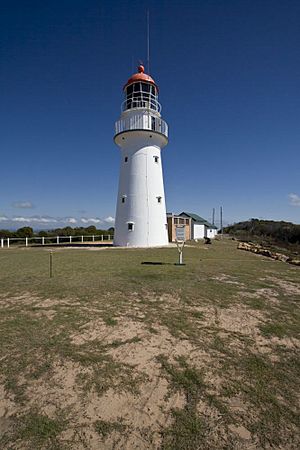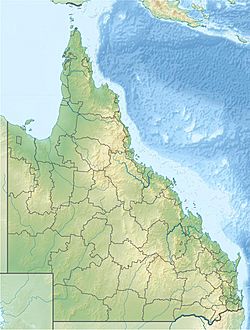Bustard Head Light facts for kids
 |
|
| Bustard Head Light, 2006 | |
|
|
|
| Location | 1770, Queensland, Australia |
|---|---|
| Coordinates | 24°01′20.0″S 151°45′50.9″E / 24.022222°S 151.764139°E |
| Year first constructed | 1868 |
| Automated | 1986 |
| Construction | cast iron tower |
| Tower shape | conical tower with balcony and lantern |
| Markings / pattern | white tower, red lantern dome |
| Height | 58 feet (18 m) |
| Focal height | 336 feet (102 m) |
| Current lens | AGA 250mm rotating lens |
| Intensity | 200,000 cd |
| Range | 21 nautical miles (39 km; 24 mi) |
| Characteristic | Fl (2) W 10s. |
| Admiralty number | K2964 |
| NGA number | 111-10452 |
| ARLHS number | AUS-017 |
The Bustard Head Light is an active lighthouse in Queensland, Australia. It stands on the southeast tip of Bustard Head. This headland is about 20 kilometres (12 mi) northwest of a town called Seventeen Seventy. The lighthouse is inside Eurimbula National Park.
It was built in 1868, making it the second-oldest lighthouse in Queensland. Only the Cape Moreton Light is older. It was also the first lighthouse built in Queensland after it became a separate state in 1859.
The Bustard Head Light is special because it was one of the first in Australia to be made from pre-made cast iron parts. These parts were then bolted together. Only one other lighthouse in Queensland, the Sandy Cape Light, was built this way. This lighthouse also helps other lighthouses by relaying signals.
Captain James Cook named Bustard Head in 1770. He named it after a large bird called a bustard. His crew shot and ate a bustard when they landed there.
Contents
History of Bustard Head Light
Queensland became a state in 1859. In 1862, the first Portmaster, Commander George Poynter Heath, was appointed. By 1864, people realized that Queensland needed more lighthouses along its coast. Bustard Head was one of the first places chosen for a new lighthouse.
Orders for the lighthouse tower and its light were placed in 1865. The tower parts came from England, and the light came from Chance Brothers in Birmingham, England. Both arrived in Brisbane in April 1867.
A company called W. P. Clark won the job to build the lighthouse. They started work in August 1867. The contract said it would take six months, but it took ten months. The light was first turned on on June 29, 1868. W. P. Clark later built several other lighthouses in Queensland.
In May 1932, the original homes for the lighthouse keepers burned down. In 1935, the stairs inside the lighthouse were moved. They used to be outside the tower.
The lighthouse became automated in 1985–86. This means machines took over the work, and lighthouse keepers were no longer needed. The last keepers left in 1986. For the next 16 years, the lighthouse was left alone and suffered damage.
In 2001, a group of volunteers called the Bustard Head Lighthouse Association took over. They got a twenty-year lease for the site. They started restoring the lighthouse and its buildings. They used money from a government grant, local businesses, and their own funds. The station is now fully restored and managed by this association.
How the Light Works Today
The light at Bustard Head flashes two times every ten seconds. It is a white light and can be seen from 21 nautical miles (39 km; 24 mi) away. The light comes from a powerful 1000-watt lamp. This lamp shines with an intensity of 200,000 cd.
The lighthouse gets its power from the main electricity supply. It also has a backup diesel engine in case the power goes out. The light uses a special rotating lens made by a company called AGA.
What the Lighthouse Looks Like
The Bustard Head Light tower is shaped like a cone. It is 18 metres (59 ft) tall. It is made from pre-made cast iron plates, which are painted white. The base of the tower spreads out, similar to the Sandy Cape Light.
At the top of the tower is a metal balcony with a simple railing. Inside, there is a spiral staircase made of cast iron steps. These stairs are attached to the inner walls of the tower. Originally, you entered the lighthouse from outside, up a flight of stairs. But in 1935, a ground-floor entrance was added, and the stairs were moved inside.
On top of the balcony is the original lantern room. This room holds the light and is about 9-foot-6-inch (2.90 m) wide. Inside the lantern room, there is a walkway. The top of the lantern is covered in copper and painted red. It has a round knob and a weather vane on top. A fence surrounds the lighthouse.
There are also two homes for the lighthouse keepers at the station. They are one-story buildings made of timber and covered with fibro (a type of building material). They have corrugated fibro roofs. One house is used by the site manager, and the other shows old lighthouse items.
Another important building is the old powerhouse. It was also made of timber and cement sheets. The new powerhouse is built from brick on a concrete base.
Other buildings include a fenced fuel storage area, a tool shed, a garage, and a large fuel storage area. Most of these are also made of timber and fibro.
There is also a cemetery about 300 metres (980 ft) northeast of the station. It has a white picket fence around it. Nine graves from 1879 to 1911 are there, along with two unmarked graves for children.
Visiting the Lighthouse
The Australian Maritime Safety Authority operates the light. The Bustard Head Lighthouse Association manages the entire site. You can only reach the site by driving a 4WD vehicle. You can take tours of the site and the lighthouse tower every day.
Images for kids





